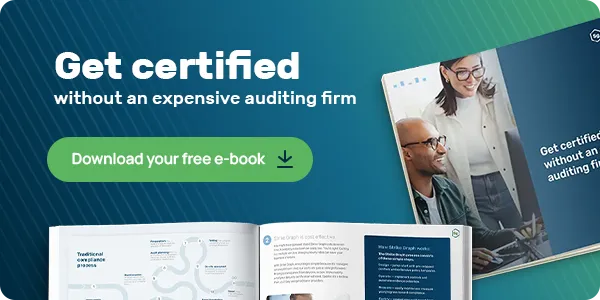Now that we’re in 2023, businesses are prioritizing their security more than ever. Compliance guidelines like SOC 2 are becoming minimum expectations for doing business with a quickly-growing number of companies.
If yours is among the many organizations with SOC 2 compliance on its list of New Year’s resolutions, you may have some questions. One that we hear from just about every company considering SOC 2 is “Can I fail the SOC 2 audit?”
Read on to learn the answer and to explore the nuances of SOC 2 audits so you start the process well prepared.
SOC 2 audits aren’t pass/fail
The short answer to the question “Can I fail a SOC 2 audit?” is no. A SOC 2 audit isn’t a pass or fail process. In other words, when an auditor performs a SOC 2 audit on your business, their goal is not to determine who fails or passes but to provide you with an opinion.
Before we go into the auditor’s opinion, let’s talk more about SOC 2 compliance and what it is. The point we want to stress here is that the controls and practices put in place to satisfy SOC 2 guidelines are specific to an organization. Since the SOC 2 standards are designed to be flexible, one company’s set of controls will be different from another as determined by their particular businesses and the services they offer.
That’s why the audit can’t be a test where questions are answered correctly or incorrectly, leading a company to pass or fail. Instead, the audit is an evaluation of how well your security program is meeting SOC 2 guidelines within your specific business context.
What is an auditor's opinion, and why is it important?
You might not care about most people’s opinions, but your SOC 2 auditor’s opinion is what counts most in your journey to compliance. Once your SOC 2 audit is complete, the auditor will present a report detailing how closely they believe your company is meeting SOC 2 standards. If they decide your security is satisfactory, your business will be deemed SOC 2 compliant.
If not, the auditor will provide an opinion determination or note any audit exceptions. Exceptions are instances in which the controls are ineffective. We’ll cover them in more detail below.
There are three different opinions depending on the modifications that the auditor thinks need to be made to the controls:
- Qualified opinion
- Adverse opinion
- Disclaimer opinion
Qualified opinion modifications
A qualified opinion indicates that the company’s controls meet SOC 2 standards, with certain exceptions. The auditor has identified one or more issues with the organization's controls, but they don’t materially affect the overall effectiveness of the controls.
So, if a business has strong controls to protect sensitive data, but there is a minor issue (such as a documentation error), the auditor might issue a qualified opinion. This would indicate that the organization's controls are generally effective, but some minor issues need to be addressed.
Adverse opinion modifications
If the organization’s controls don’t meet the SOC 2 standards, the auditor issues an adverse opinion. This is the most serious type of opinion modification, and it means that the business has significant weaknesses in its controls that need to be addressed.
For example, inadequate access controls or insufficient security measures might be cause for an adverse opinion. In order to meet SOC 2 standards, the business must address these significant issues.
Disclaimer opinion modifications
This third option actually indicates a lack of an opinion. In the case of a disclaimer opinion, the auditor is unable to complete the audit, whether due to a lack of information or insufficient evidence to support their assessment.
To correct this, businesses should promptly consult with the auditor to bridge the necessary gaps and work toward being able to complete the audit.

What is an audit exception?
An audit exception is a deviation from SOC 2 standards as a result of an ineffective or faulty control or a misstatement on behalf of the organization. Understanding exceptions is crucial because every attempt should be made to avoid them. There are three types of exceptions.
Control design deficiency
Controls are only as effective as their design. If a control is designed to achieve a specific outcome, but that outcome is hindered by its design, this is a design deficiency. To fix this, the business may need to tweak the process behind the control or rework it entirely.
Control effectiveness deficiency
In some cases, a control simply fails to accomplish its desired outcome. Let’s say there’s a control meant to give only authorized users access to specific data. If an auditor were to come in and see that unauthorized users had also accessed this data, the control would be deemed ineffective.
System description misstatements
Sometimes, companies make misstatements about the nature of their services, whether intentionally or unintentionally. This is an area in which the auditor can note an exception if there is a misalignment between what the business does and what it says it does.
One thing to keep in mind in all of these cases is that the goal of an audit isn’t to avoid all exceptions. Even though you may receive an exception, you may still do well in your audit if you have controls that compensate for or mitigate the risk.
Now that you know this, we can move on to discussing more about preparing for your SOC 2 audit and what you can expect. Our hope is that, by arming you with knowledge, we can help reduce potential anxiety surrounding the process.
How should I prepare for a SOC 2 audit?
Preparing for a SOC 2 audit takes time, but the amount of time it takes depends on your organization’s maturity and how much bandwidth your team can dedicate to the prep process.
Here’s what that process looks like, in a general sense:
- Familiarize yourself with the SOC 2 framework: If you understand the framework, you’ll have a better idea of what the auditing firm will be looking for during the audit.
- Review your current controls: It’s important to make sure your controls are adequately designed and operating effectively. In this stage, you can identify any areas where controls are insufficient or not operating as intended and take steps to address these issues.
- Document your controls: Make sure you have documentation in place for all of your controls, including policies, procedures, and any supporting documentation such as contracts or vendor agreements. This will help the auditing firm understand how your controls are designed and how they are being implemented.
- Conduct a mock audit: A mock audit is a great way to identify any areas where you may be vulnerable, and it allows you to practice for the actual audit so you can identify and address any issues before the auditing firm arrives.
- Communicate with the auditing firm: By keeping in regular communication with the auditing firm leading up to the audit, you can feel more relaxed knowing that you are prepared and that the auditing firm has all the information it needs.
Do all of these steps, and you’ll be on the right track to a productive, smooth SOC 2 audit.
How Strike Graph can help
At Strike Graph, we believe that it’s time to modernize the audit process. In the past, hiring a subjective auditing firm and jumping through their auditors’ hoops to achieve SOC 2 compliance was a given. But now you have a better choice.
Strike Graph’s compliance operation and certification platform takes you all the way from the initial design of your security program through to certification. No extra vendors required. And, we do it far faster and more affordably than traditional methods.
Even better, our technology-enabled audit approach means full transparency with objective, repeatable audit results that prove SOC 2 compliance to build trust with your partners and customers.
.jpg?width=1448&height=726&name=Screen%20Shot%202023-02-09%20at%202.57.5-min%20(1).jpg)










